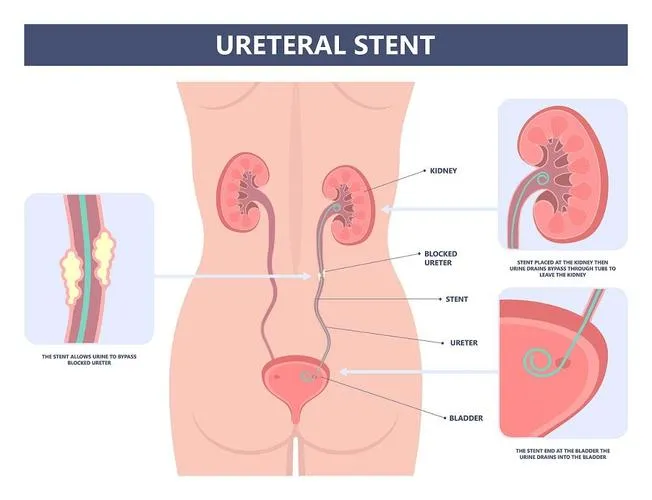What Is Ureteral Stenting? Procedure and Recovery
September 27, 2022
Ureteral stents are small, hollow, and flexible tubes inserted into the ureter (a tube-like structure that helps in the transportation of urine from the kidney to the urinary bladder) to treat various ureteral obstructions. Though ureteral stents are temporary, you may require one longer depending on the reason for its use.
Why is ureteral stenting needed?
Ureteral stenting is needed in the following cases:
- To prevent blockage of the ureters with the fragments after breaking up kidney stones
- To prevent postoperative swelling of the ureter after kidney stone removal
- To treat ureteral obstructions due to blood clots, scar tissue, ureteral stones, and inflammatory bowel diseases
Who is qualified to perform ureteral stenting?
Ureteral stenting is usually performed by a urology specialist. A urologist is a doctor who specializes in diagnosing and treating diseases of the urinary tract in both men and women and the reproductive tract in men.
What is the procedure for ureteral stenting?
Pre-procedure
- Prior to a ureteral stenting, your urologist will advise certain blood tests and imaging tests to check your kidney function.
- You will be asked to stop taking certain medications, like blood thinners.
- You will also need to fast a few hours prior to the procedure, as advised by your urologist.
Procedure
- Ureteral stenting is usually performed as an outpatient procedure.
- Prior to the procedure, you will receive general anaesthesia for ease of the procedure.
- Using X-ray imaging as a guide, your urologist will insert a small device called a cystoscope to help locate the obstruction and thread the guide wire for the stent.
- The guidewire will be used to place the ureteral stent. The upper part of the stent has a coil that resides within the kidney. On the lower end is a loop that resides within the bladder. The coils of the stent will hold it in place.
- Once it is secured, the guide wire is removed and the stent remains in place.
Post-procedure
- After the procedure, your urologist will advise you when it is safe to return home.
- You may experience some blood in the urine, discomfort or pain on urination in the stented kidney, which will resolve after the stent is removed.
What are the benefits of ureteral stenting?
Ureteral stenting has several benefits, as listed below.
- Helps drain your kidney.
- Aids in healing urinary tract infections.
- Reduces the risk of serious complications like swelling and ureteral blockage.
If you have further doubts or concerns, do not hesitate to call a urologist or request an appointment at Apollo Spectra Hospitals, Call 18605002244. Apollo Spectra Hospitals boast of some of the best urologists who continuously aim to improve surgical results, reduce recovery time, and practise advanced surgical techniques par excellence.
What are the risks of ureteral stenting?
Certain complications are listed below:
- Blood in urine
- Increased frequency, urgency or burning when passing urine
- Pain in the kidney when passing urine
- Blocked, broken or dislodged stents
- Infections like urinary tract infections (UTIs)
What is the recovery process after ureteral stenting?
After ureteral stenting, you will be required to be aware of the following restrictions and care.
- Pain relief - Your doctor will advise you on what pain medication you can take to relieve pain and discomfort post procedure.
- Fluid intake - Consume at least 2-3 litres of water per day to prevent further stone formation and UTIs.
- Physical activity - For a week after the procedure, avoid strenuous physical activity. Avoid lifting heavy weights for 24 hours after the procedure.
- Sexual activity - Avoid sexual activity for a week after stent placement to reduce your risk of UTI.
Conclusion
Ureteral stents are safe and do not cause any long-term problems. Though they come with their own post-procedure side effects, they are useful for allowing kidney stones to pass or for resolving any ureteral obstruction. With the right approach and care, this procedure will benefit you and prevent further complications.
If you experience symptoms such as dark, cloudy or foul-smelling urine, clots of tissue in urine, nausea and vomiting, extreme pain, burning sensation, difficulty peeing or fever or chills, contact your doctor immediately.
Though there is no research to back this answer, it is seen that patients experience less pain when sleeping on the side opposite to that of the stent placement.
Stents can remain in place for a week to six months or more, depending on the cause of obstruction and the type of treatment.
NOTICE BOARD
CONTACT US
CONTACT US
 Book Appointment
Book Appointment


.svg)
.svg)
.svg)
.svg)








